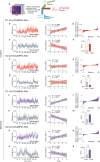This is a preprint.
Drugs of abuse hijack a mesolimbic pathway that processes homeostatic need
- PMID: 37732251
- PMCID: PMC10508763
- DOI: 10.1101/2023.09.03.556059
Drugs of abuse hijack a mesolimbic pathway that processes homeostatic need
Update in
-
Drugs of abuse hijack a mesolimbic pathway that processes homeostatic need.Science. 2024 Apr 19;384(6693):eadk6742. doi: 10.1126/science.adk6742. Epub 2024 Apr 19. Science. 2024. PMID: 38669575 Free PMC article.
Abstract
Addiction prioritizes drug use over innate needs by "hijacking" brain circuits that direct motivation, but how this develops remains unclear. Using whole-brain FOS mapping and in vivo single-neuron calcium imaging, we find that drugs of abuse augment ensemble activity in the nucleus accumbens (NAc) and disorganize overlapping ensemble responses to natural rewards in a cell-type-specific manner. Combining "FOS-Seq", CRISPR-perturbations, and snRNA-seq, we identify Rheb as a shared molecular substrate that regulates cell-type-specific signal transductions in NAc while enabling drugs to suppress natural reward responses. Retrograde circuit mapping pinpoints orbitofrontal cortex which, upon activation, mirrors drug effects on innate needs. These findings deconstruct the dynamic, molecular, and circuit basis of a common reward circuit, wherein drug value is scaled to promote drug-seeking over other, normative goals.
Figures





References
-
- Hyman S. E., Malenka R. C., Nestler E. J., Neural mechanisms of addiction: the role of reward-related learning and memory. Annu Rev Neurosci 29, 565–598 (2006). - PubMed
-
- Koob G. F., Le Moal M., Drug addiction, dysregulation of reward, and allostasis. Neuropsychopharmacology 24, 97–129 (2001). - PubMed
-
- Kalivas P. W., Volkow N. D., The neural basis of addiction: a pathology of motivation and choice. Am J Psychiatry 162, 1403–1413 (2005). - PubMed
-
- Robinson T. E., Berridge K. C., The neural basis of drug craving: an incentive-sensitization theory of addiction. Brain Res Brain Res Rev 18, 247–291 (1993). - PubMed
-
- Ahmed S. H., Koob G. F., Transition from moderate to excessive drug intake: change in hedonic set point. Science 282, 298–300 (1998). - PubMed
Publication types
Grants and funding
LinkOut - more resources
Full Text Sources
